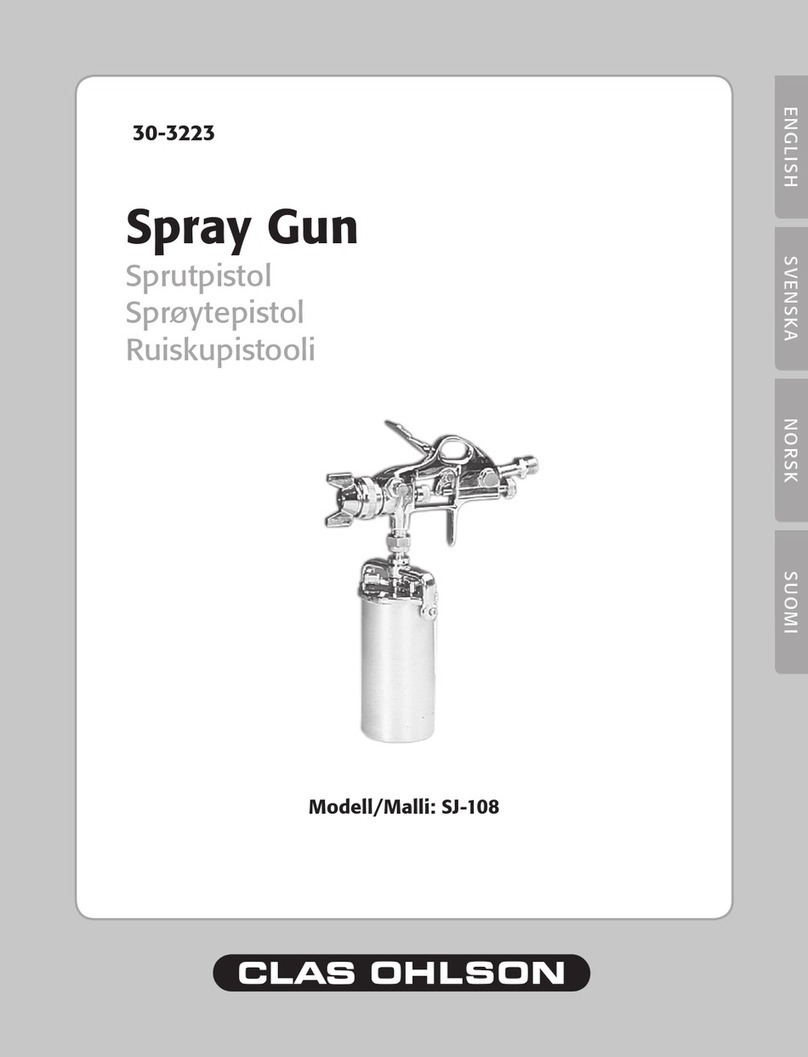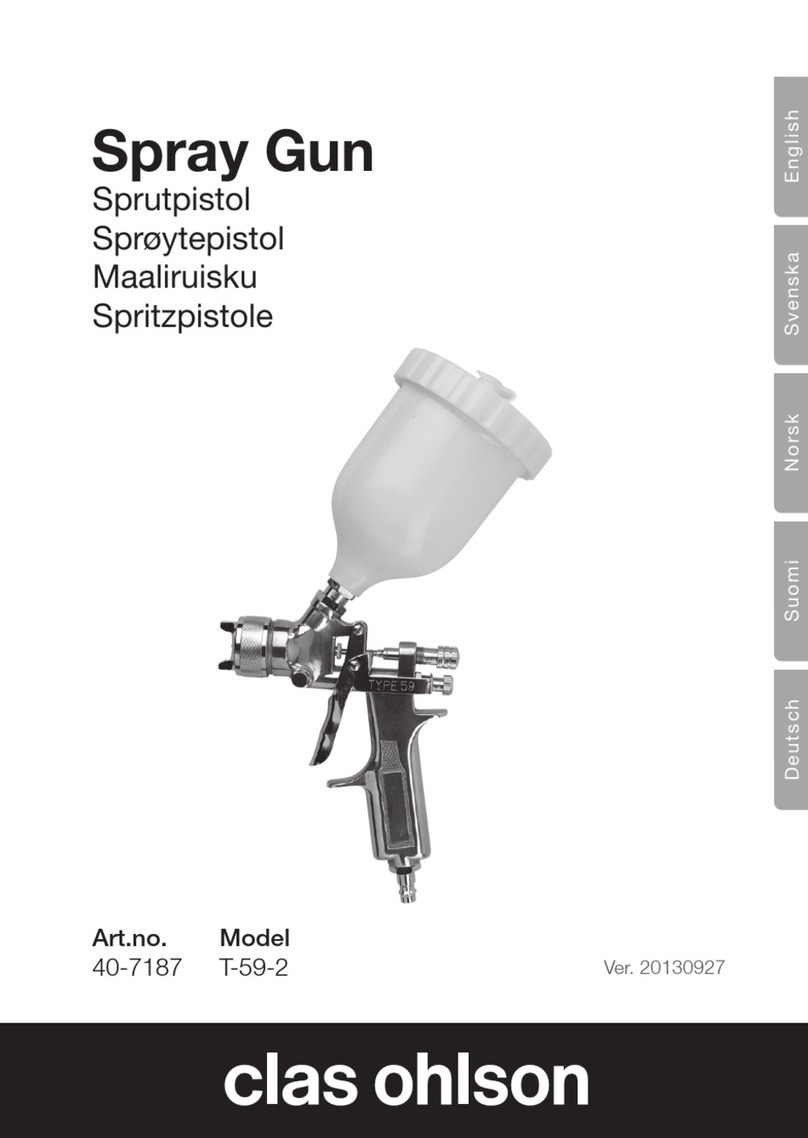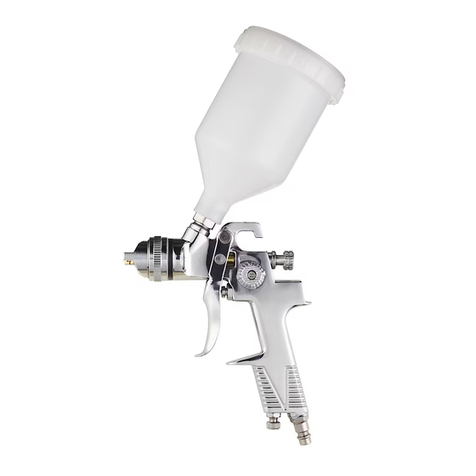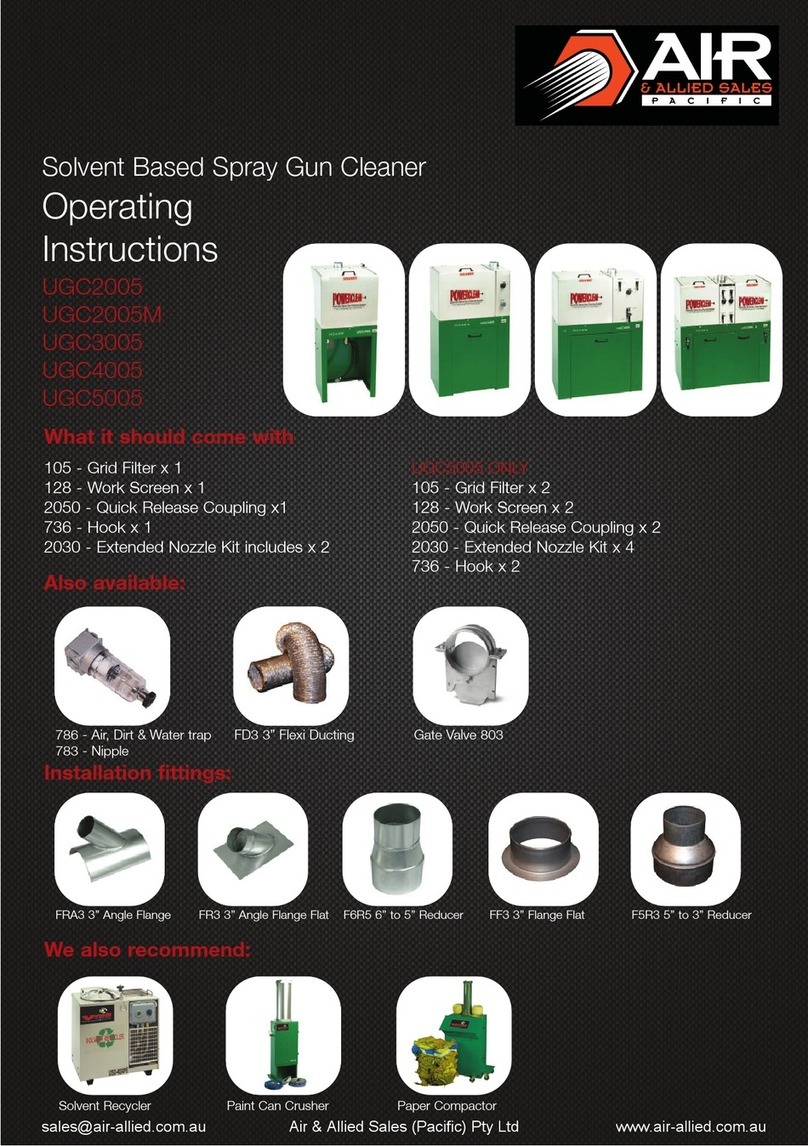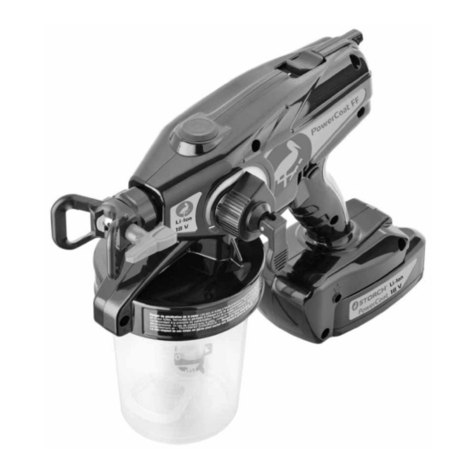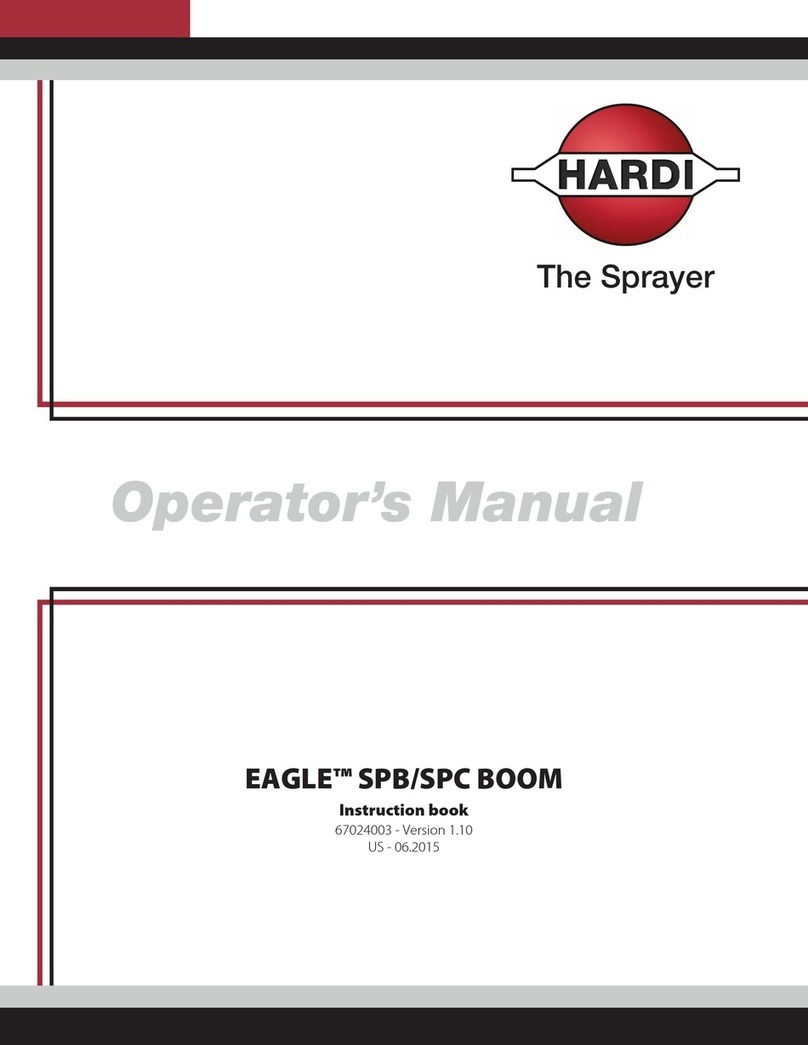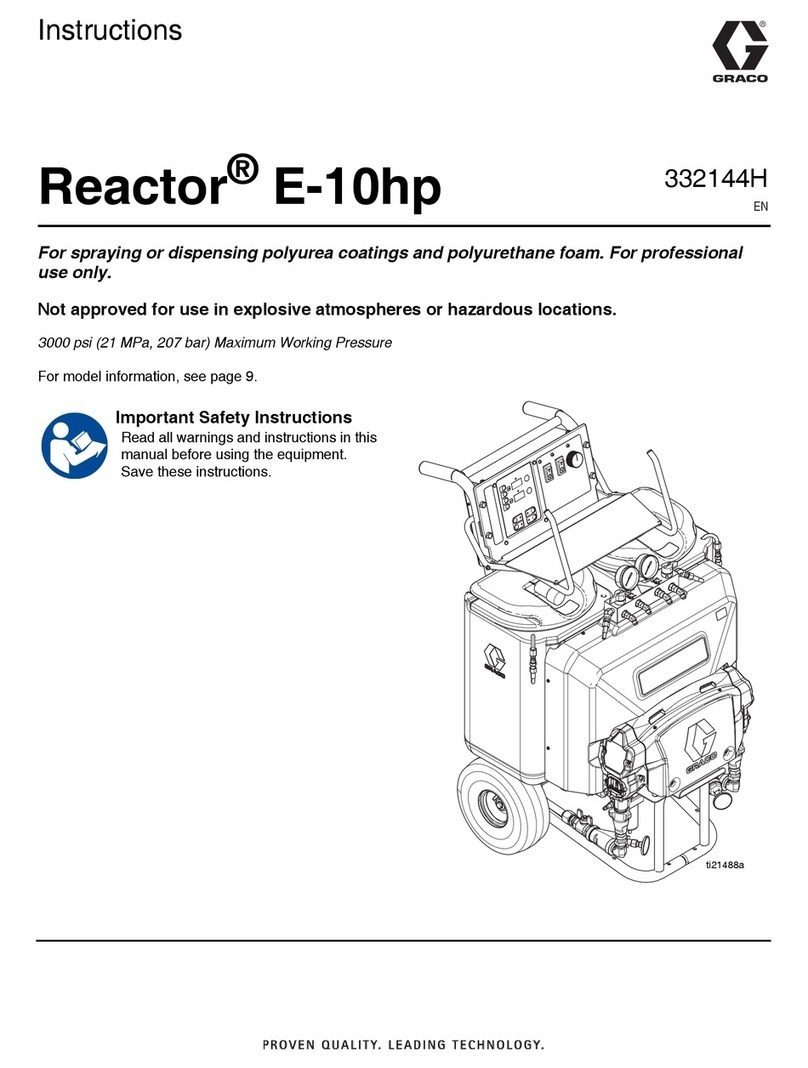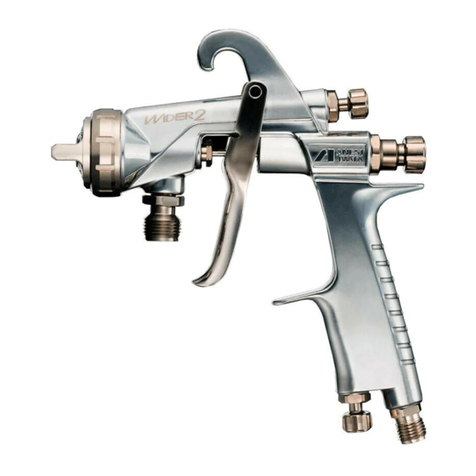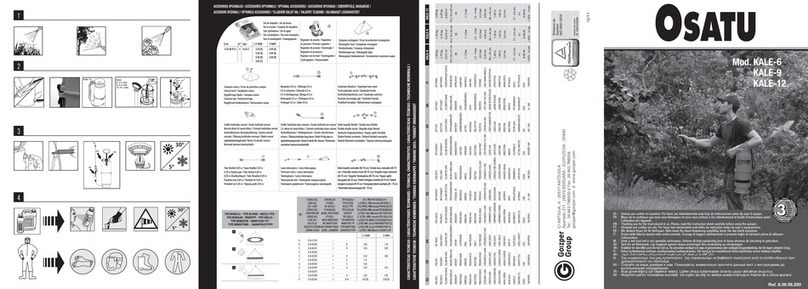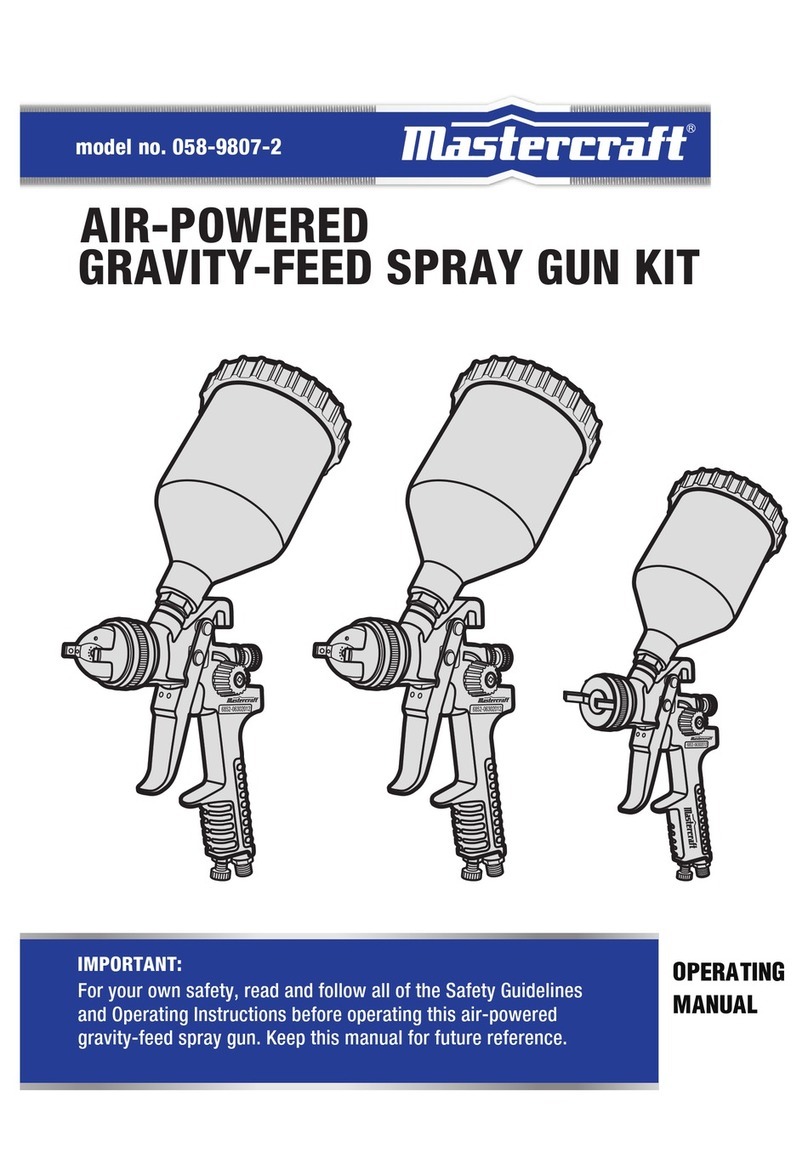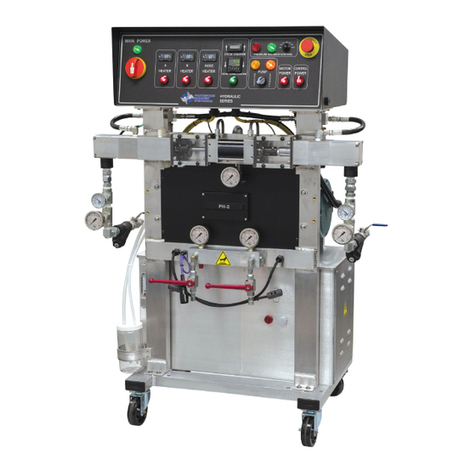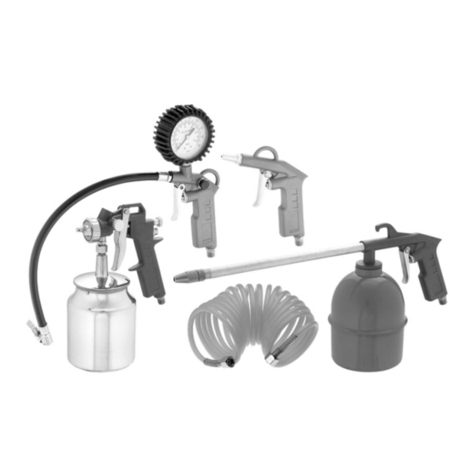Clas Ohlson FL-999 User manual

Important!
Read the entire instruction manual carefully
and make sure that you fully understand
it before you use the equipment. Keep the
manual for future reference.
Viktig information:
Läs hela bruksanvisningen noggrant och
försäkra dig om att du har förstått den innan
du använder utrustningen och spara den för
framtida bruk.
Viktig informasjon:
Les disse anvisningene nøye og forsikre deg
om at du forstår dem før du bruker enheten
og oppbevar dem for senere bruk.
Tärkeätä tietoa:
Lue nämä ohjeet huolellisesti ja varmista
että olet ymmärtänyt ne, ennen kuin alat
käyttää laitetta. Säilytä ohjeet myöhempää
tarvetta varten.
Färgspruta
Malingssprøyte
Maaliruisku
Art.no Model
18-3056 FL-999-UK
30-9579 FL-999
ENGLISHSVENSKANORSKSUOMI
Spray Gun
Ver. 200802


3
ENGLISH
Spray Gun
Art.no: 18-3056 Model: FL-999-UK
30-9579 FL-999
Please read the entire instruction manual before using and save it for future use.
We apologise for any text or photographic errors and any changes in technical data.
If you have any questions concerning technical problems please contact our Custo-
mer Service Department (see address on reverse.)
Table of Contents
Description
Safety
Before starting
Use
Cleaning
Care and Maintenance
Troubleshooting Guide
Disposal
Technical Specications

4
ENGLISH
4
35
1
2
1
2
3
4
5
6
7
8
9
Description
Contents
1. Spray Gun
2. Flexible Extension
3. Viscosity Cup
4. Non-Return Valve
5. Paint Container with Suction Tube
and Filter
Parts Guide
1. Motor Housing
2. Output Control Knob
3. Trigger
4. Handle
5. Paint Container
6. Nozzle
7. Flexible Extension
8. Non-Return Valve
9. Viscosity Meter

5
ENGLISH
General Safety Instructions
Warning: Read all the instructions. Failing to adhere to the following instructions
may lead to electric shocks, res and/or serious injury. The term “electrical hand
tools” in the warning text below is referring to your mains operated or battery
operated hand tool. Save the instructions.
1) The Work Area
a) Keep the work space clean and well illuminated. Cluttered and poorly lit
areas invite accidents.
b) Do not use electrical hand tools in explosive environments, i.e. nearby
ammable liquids, gas or dust. Electrical hand tools generate sparks that
could easily ignite dust or fumes.
c) Keep away from children and other spectators while using the electrical
hand tool. Disturbances can cause you to lose your concentration and control.
2) Electrical Safety
a) The electrical hand tool’s plug must t correctly into the wall socket. Never
modify the plug in any way. Never use an adaptor together with earthed
electrical hand tools. Unmodied plugs and suitable wall sockets decrease the
risk of electric shock.
b) Avoid physical contact with earthed objects, such as pipes, radiators,
ovens or refrigerators. There is an increased risk of electrical shock if your
body is earthed.
c) Do not expose the electrical hand tool to rain or other wet conditions.
If water gets inside an electrical hand tool it increases the risk of electrical
shock.
d) Do not abuse the lead. Never use the lead to carry the tool, drag or pull the
plug out of the wall socket. Keep the lead away from heat, oil, sharp edges
and movable parts. Damaged or tangled leads increase the risk of electrical
shock.
e) When you use an electrical hand tool outdoors; use an extension cord
suitable for this purpose. Use of an extension cord for outdoor use decreases
the risk of electrical shock.

6
ENGLISH
3) Personal Safety
a) Pay attention to what you do and use common sense when using electrical
hand tools. Never use an electrical hand tool if you are tired or under
the inuence of drugs, alcohol or medication. One moment of not paying
attention while using an electrical hand tool may result in serious injury.
b) Use protective equipment. Always use safety glasses. Using protective
clothing such as a face mask, non-slip safety shoes, a helmet and ear defenders
when needed decreases the risk of injury.
c) Avoid accidental starts. Make sure that the power switch is set to OFF
before you connect the device to the wall socket. Never carry an electrical
hand tool with one nger on the trigger or never connect the hand tool to a wall
socket when the switch is set to ON, since it may result in injury.
d) Remove all service tools/keys before switching on the hand tool.
A service tool forgotten on a rotating part of the electrical hand tool may result in
injury.
e) Do not overreach. Make sure you stand steady and well balanced at all
times. This gives better control in unexpected situations.
f) Wear suitable clothing. Do not wear loose tting clothes or jewellery. Keep
hair, clothes and gloves away from movable parts. Loose tting clothes,
jewellery or long hair could get caught in movable parts.
g) If the equipment for suctioning or collecting dust is available make sure
it is connected and used properly. Using technical aids may decrease dust
related hazards.
4) Use and maintenance of the electrical hand tool.
a) Do not force the hand tool. Use a hand tool suitable for the work you are to
perform. The correct electrical hand tool will perform the task better and safer if
used at the correct feed rate.
b) Never use the electrical hand tool if the power switch does not switch the
tool on and off properly. All electrical hand tools that cannot be controlled by
the power switch are dangerous and must be repaired.
c) Unplug the lead from the wall socket before making any adjustments,
changing accessories or storing the electrical hand tool away. These
precautions reduce the risk of the electrical hand tool starting unexpectedly.
d) Store electrical hand tools that are not being used out of the reach of
children. Do not allow people who are unfamiliar with the tool or its
functions to operate the tool. Electrical hand tools can be dangerous if they
get into the hands of inexperienced users.

7
ENGLISH
e) Maintenance of electrical hand tools. Check if anything is incorrectly set,
if moving parts are catching, if anything is broken or if there is anything
which could cause the electrical hand tool to malfunction. If something
is damaged it must be repaired before use. Many accidents are caused by
poorly maintained electrical hand tools.
f) Keep the tools sharp and clean. Properly maintained cutting tools with sharp
blades are less likely to jam and are easier to control.
g) Use the electrical hand tool, accessories and such according to the
instructions and in a way suitable for the type of electrical hand tool
used. Using the electrical hand tool for work other than suitable work could
result in a dangerous situation.
5) Service
a) Repairs and service should only be performed by qualied persons, and
only with original spare parts. This guarantees the safety of the electrical
hand tool.

8
ENGLISH
Safety Symbols
Read the entire instruction manual
Safety glasses or a visor, a face mask
and ear protectors must be worn.
Safety Instructions Specific to Spray Guns
• Do not use the spray gun for easily ignitable* paints or substances.
• Do not use the spray gun with liquids containing particles or bres such as
metallic paint, re-retardant paint and paints containing asbestos.
• Do not clean the spray gun using easily ignitable solvents.
• Be aware of any possible hazards due to the nature of the material being
painted.
• Carefully read all the instructions and warning texts for the product to be used
in the spray gun including any requirements for protective clothing.
• Do not use any paint product without knowing how dangerous it is.
• Always pull the plug out of the power point when you stop working
(to prevent unexpected starts).
• Never point the spray gun at yourself or anyone else.
* Substances/liquids having a ash point above 55 °C.

9
ENGLISH
Before Starting
Practice
When using the spray gun for the rst time it
is advisable to practice spraying on a piece of
waste chipboard or similar to get a feel for the
spray gun.
1. Make sure that the suction tube is securely
fastened onto the front tube in the lid of the
paint container. Make sure that the non-
return valve is in place and that the nozzle is
Viscosity
The viscosity cup and a clock or watch are all that are needed to check the
viscosity of the paint.
1. Fill the measuring cup by dipping it into the paint (stir the paint rst if
it is lumpy).
2. Lift the cup above the surface of the paint and time how long it takes for the
paint to run through the hole at the bottom of the cup. (The longer it takes,
the higher the viscosity (thickness) of the paint.)
screwed on.
2. The pressure can be adjusted using the knob
on the handle. Set the pressure to medium
before starting to spray and then adjust whilst
spraying.

10
ENGLISH
Viscosity Table
Note: These viscosities are only recommendations. Test the spray gun on
a surface with the same texture and incline as that to be sprayed before spraying
the real object if you are the least bit unsure as to which viscosity is suitable.
Plastic and latex paint 24-28 seconds
Water based paint 20-25 seconds
Primer 24-26 seconds
Varnish 20-25 seconds
Oil based paint 18-22 seconds
Enamel paint 18-22 seconds
Aluminium paint 22-25 seconds
Car underseal 25-35 seconds
Wood sealant 28-35 seconds
Anti-corrosive paint No thinning required
Wood stain No thinning required
Use
Preparations
Note: Never start the spray gun without liquid in the container; it can shorten
the life of the pump.
1. Make sure that the power supply that you are using is compatible with the
rated power of the tool.
2. Pour the liquid to be sprayed into the container.
3. Thin the liquid if necessary and check its viscosity.
4. Place the container on a level surface; cover the surface with paper to catch
any drops.
5. Hold the spray gun over the container and attach the container by screwing the
container anticlockwise.
6. The spray gun is now ready for use.

11
ENGLISH
Right Wrong
Operating Instructions
Adjust the paint flow using the control knob (2):
Reduce the ow by turning the knob clockwise (B)
or increase the ow by turning it anticlockwise (A).
• Practice on a piece of scrap material if you are unsure.
• Keep the spray gun level and parallel to the surface at all times.
• For best results, sweep the spray gun in a smooth motion using the whole arm.
Do not direct the spray by exing your wrist.
Spraying
• As a rule, 30 cm is the ideal distance between the nozzle and the surface to
be sprayed. A greater distance can produce too widespread a spray pattern
and a lesser distance can create too thick a layer of paint.

12
ENGLISH
• Sweep the spray gun from side to side and
up and down. For best results, start spraying
a little outside the actual spray area.
• When spraying large areas, use a criss-
cross pattern.
• To prevent running when painting vertical surfaces, rst cover the surface with
a thin coat by spraying a ne spray from a greater distance and not spraying
too much paint on each sweep. The nal coat can be made from a closer
distance.
• On horizontal surfaces the spray gun should be angled at 45° and pointed
away from you.
• If the spraying is interrupted it is advisable to restart spraying on a piece
of paper before resuming.
Thinning
If the paint forms a stream instead of a mist it needs to be thinned further. Water
based paints are thinned using water, oil based paints use thinners such as white
spirits.

13
ENGLISH
Cleaning
Note: Never immerse the entire spray gun into cleaning uid.
After each use
1. Remove the container and pull out the suction tube.
2. Unscrew the four screws (13) under the container lid (12).
3. Detach the container lid from the motor housing (19) by pulling it downwards.
4. Remove the pump assembly from the motor housing. Take the pump apart and
clean all the components using a suitable paint thinner.
5. When reassembling the pump, make sure that the piston (11), piston spring
(10), non-return valve (8) and nozzle (6) are correctly aligned.
6. Plug the spray gun into a 230 V power point and hold it upside down. Pour a
little thin oil into the hole for the suction tube and pull the trigger. This will coat
the piston and cylinder with oil and prevent rust.
Note: Insufcient or incorrect cleaning can lead to the piston jamming in the
cylinder. If a faint humming sound can be heard whilst spraying, release the
trigger immediately. Otherwise the motor can overheat and become damaged.
1
11 10
13
12
8 6

14
ENGLISH
Care and Maintenance
Remember to check the parts that wear out such as the nozzle, piston, spring, etc
after having sprayed 20–40 litres of paint. Be extra vigilant when using latex paint
as it wears out the parts more quickly than other types of paint.
When to replace worn parts
1. Nozzle (6): When the paint no longer forms a ne spray and starts spitting out
instead.
2. Piston (11): Inspect regularly, change if necessary.
3. Non-return valve (8): Inspect the size of the three holes in the valve and the
evenness of the front surface. A worn valve that has scratches and damaged
holes must be replaced.
Disposal
Follow local ordinances when disposing of this product.
If you are unsure about how to dispose of this product
contact your municipality.
Specifications
Power Supply: 230 V AC, 50 Hz
Power: 75 W
Container Volume: 900 ml
Flow Rate: 200 ml/min
Cable Length: 3 m
Weight: 1.45 kg
Vibration X axis: 1.94 m/s²
Y axis: 4.94 m/s²
Z axis: 13.19 m/s²
Sound Pressure: LpA: 87.7 dB
Sound Power: LwA: 100.7dB

15
ENGLISH
Troubleshooting Guide
Problem Cause Remedy
Atomizing. Nozzle too far away. Hold it 30 cm away.
Paint too thin. Use thicker paint.
Pressure too high. Turn the output control
clockwise.
Worn nozzle Replace nozzle.
Overheated
motor.
Spraying too long. Allow spray gun to cool for
a few minutes.
Motor runs but does not spray. Check lter and non-return
valve.
Thin the paint.
Motor hums but
does not spray.
Output control set wrong. Adjust setting.
Piston worn from acrylic paint spraying. Remove pump unit and
thoroughly clean all parts.
Faulty motor. Lubricate the piston and
cylinder.
Motor runs but
does not spray.
Paint too thick Thin the paint.
Nozzle blocked Thoroughly clean.
Non-return valve missing. Replace it.
Non-return valve worn or blocked. Clean or change it.
Output control needs adjusting. Adjust it.
Suction lter is clogged. Clean or change it.
The motor does
not start.
No mains power supply. Check fuse.
Faulty motor.
Paint “spits”
and motor
sounds strange.
Output control set wrong. Adjust control knob.
Worn non-return valve or worn nozzle. Replace worn part.
Nozzle aperture too large. Change to a smaller one.
Paint too thick. Thin the paint.
Spray gun held at too high an angle,
no paint can enter the suction tube.
Hold the gun upright or add
an extension to the tube.
Paint leaking
from the back
of the pump
assembly.
Gun pointed upwards when spraying. Hold gun level.
Scratched piston or cylinder. Replace worn part.

16
SVENSKA
Färgspruta
Art.no: 18-3056 Model: FL-999-UK
30-9579 FL-999
Läs igenom hela bruksanvisningen före användning och spara den sedan
för framtida bruk. Vi reserverar oss för ev. text- och bildfel samt ändringar
av tekniska data. Vid tekniska problem eller andra frågor, kontakta vår kundtjänst
(se adressuppgifter på baksidan).
Innehållsförteckning
Beskrivning 4
Säkerhet 5
Innan du börjar 9
Användning 10
Rengöring 13
Skötsel och underhåll 14
Avfallshantering 15
Tekniska specikationer 16
Felsökningsschema 14

17
SVENSKA
4
35
1
2
1
2
3
4
5
6
7
8
9
Beskrivning
Förpackningen innehåller
1. Färgspruta
2. Böjbar förlängning
3. Viskositetsbägare
4. Backventil
5. Färgbehållare med sugrör och lter
Färgsprutans delar
1. Motorenhet
2. Mängdratt
3. Strömbrytare
4. Handtag
5. Färgbehållare
6. Munstycke
7. Böjbar förlängning
8. Backventil
9. Viskositetsmätare

18
SVENSKA
Generella säkerhetsinstruktioner
Varning! Läs alla instruktioner. Om nedanstående instruktioner inte följs kan detta
leda till elektrisk stöt, brand och/eller allvarlig skada. Termen ”elektriskt handverk-
tyg” i varningstexten nedan refererar till ditt nätanslutna eller batteridrivna hand-
verktyg. Spara dessa instruktioner!
1) Arbetsutrymmet
a) Håll arbetsutrymmet rent och väl upplyst. Belamrade och mörka utrymmen
inbjuder till olyckor.
b) Använd inte elektriska handverktyg i explosiva miljöer, som i närheten av
lättantändliga vätskor, gaser eller damm. Elektriska handverktyg genererar
gnistor som kan antända damm eller ångor.
c) Håll undan barn och åskådare medan du använder det elektriska
handverktyget. Störningsmoment kan göra att du tappar kontrollen.
2) Elektrisk säkerhet
a) Det elektriska handverktygets stickpropp måste passa i vägguttaget.
Modiera aldrig stickproppen på något vis. Använd aldrig adapter
tillsammans med jordade elektriska handverktyg. Omodierade stickproppar
och passande vägguttag minskar risken för elektrisk stöt.
b) Undvik kroppskontakt med jordade föremål, som rör, element, köksspis
eller kylskåp. Det nns ökad risk för elektrisk stöt om din kropp är jordad.
c) Utsätt inte det elektriska handverktyget för regn eller våta förhållanden.
Om vatten tränger in i ett elektriskt handverktyg ökar det risken för elektrisk
stöt.
d) Misshandla inte nätsladden. Använd aldrig nätsladden för att bära, dra eller
rycka stickproppen ur vägguttaget. Håll nätsladden undan från värme, olja,
vassa kanter och rörliga delar. Skadade eller trassliga nätsladdar ökar risken
för elektrisk stöt.
e) När du använder ett elektriskt handverktyg utomhus, använd en
skarvsladd anpassad för detta ändamål. Användning av en skarvsladd för
utomhusbruk minskar risken för elektrisk stöt.

19
SVENSKA
3) Personlig säkerhet
a) Var uppmärksam på vad du gör och använd sunt förnuft när du använder
ett elektriskt handverktyg. Använd inte ett elektriskt handverktyg om du
är trött eller påverkad av droger, alkohol eller medicinering. Ett ögonblicks
ouppmärksamhet när du använder ett elektriskt handverktyg kan resultera
i allvarlig personskada.
b) Använd skyddsutrustning. Bär alltid skyddsglasögon. Användning av
skyddsutrustning som andningsskydd, halksäkra skyddsskor, hjälm och
hörselskydd vid behov minskar risken för personskada.
c) Undvik oavsiktlig start. Se till att strömbrytaren är i läge ”OFF” innan du
ansluter stickproppen till vägguttaget. Att bära ett elektriskt handverktyg
med ett nger på strömbrytaren/avtryckaren eller att ansluta ett elektriskt
handverktyg till elnätet när strömbrytaren är i läge ”ON” inbjuder till olyckor.
d) Tag bort alla serviceverktyg/nycklar innan du slår på det elektriska
handverktyget. Ett kvarglömt serviceverktyg på en roterande del av det
elektriska handverktyget kan reslutera i personskada.
e) Sträck dig inte för långt. Se till att du står stadigt med god balans hela
tiden. Detta möjliggör bättre kontroll i oväntade situationer.
f) Bär lämplig klädsel. Bär inte löst sittande kläder eller smycken. Håll hår,
kläder och handskar undan från rörliga delar. Lösa kläder, smycken eller långt
hår kan fastna i rörliga delar.
g) Om utrustning för utsugning och uppsamling av damm nns tillgängligt,
se till att denna är ansluten och används ordentligt. Användning av dessa
hjälpmedel kan minska dammrelaterade faror.
4) Användning och underhåll av det elektriska handverktyget
a) Pressa inte det elektriska handverktyget. Använd ett elektriskt handverktyg
som är avsett för det arbetsmoment du utför. Korrekt elektriskt handverktyg gör
jobbet bättre och säkrare med avsedd matningshastighet.
b) Använd inte det elektriska handverktyget om strömbrytaren inte slår
på och stänger av verktyget. Alla elektriska handverktyg som inte kan
kontrolleras med strömbrytaren är farliga och måste repareras.
c) Tag stickproppen ur vägguttaget innan du utför några justeringar, byter
tillbehör eller lägger undan det elektriska handverktyget för förvaring.
Dessa åtgärder i förebyggande syfte minskar risken för att starta det elektriska
handverktyget oavsiktligt.

20
SVENSKA
d) Förvara elektriska handverktyg som inte används utom räckhåll för
barn och låt inte personer som inte är förtrogna med det elektriska
handverktyget eller dessa instruktioner använda det. Elektriska
handverktyg är farliga om de kommer i händerna på ovana användare.
e) Underhåll elektriska handverktyg. Kontrollera om något är felinställt, om
rörliga delar kärvar, om delar har gått sönder eller något annat som kan
påverka funktionen av det elektriska handverktyget. Om något är skadat
måste det repareras före användning. Många olyckor beror på dåligt
underhållna elektriska handverktyg.
f) Håll verktygen vassa och rena. Ordentligt underhållna skärverktyg med
vassa eggar är mindre benägna att kärva och lättare att kontrollera.
g) Använd det elektriska handverktyget, tillbehör och liknande enligt
instruktionerna och på det sätt som är ämnat för just den typen av
elektriskt handverktyg, och ta även hänsyn till arbetsförhållandena
och den typ av arbete som ska utföras. Användning av det elektriska
handverktyget för arbeten andra än vad det är ämnat för kan resultera
i en farlig situation.
5) Service
a) Låt behörig personal utföra service och reparationer, endast med
originalreservdelar. Detta garanterar att säkerheten på det elektriska
handverktyget behålls.
This manual suits for next models
1
Table of contents
Languages:
Other Clas Ohlson Paint Sprayer manuals
Popular Paint Sprayer manuals by other brands
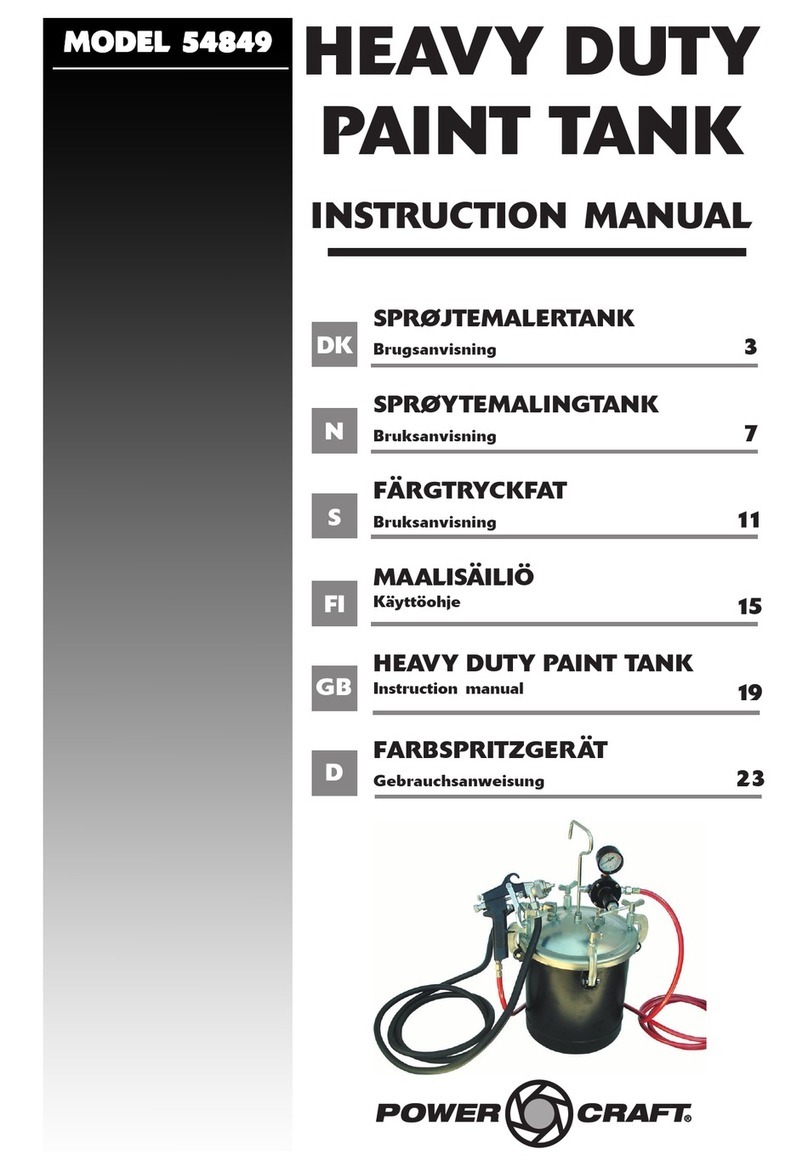
Power Craft
Power Craft 54849 instruction manual
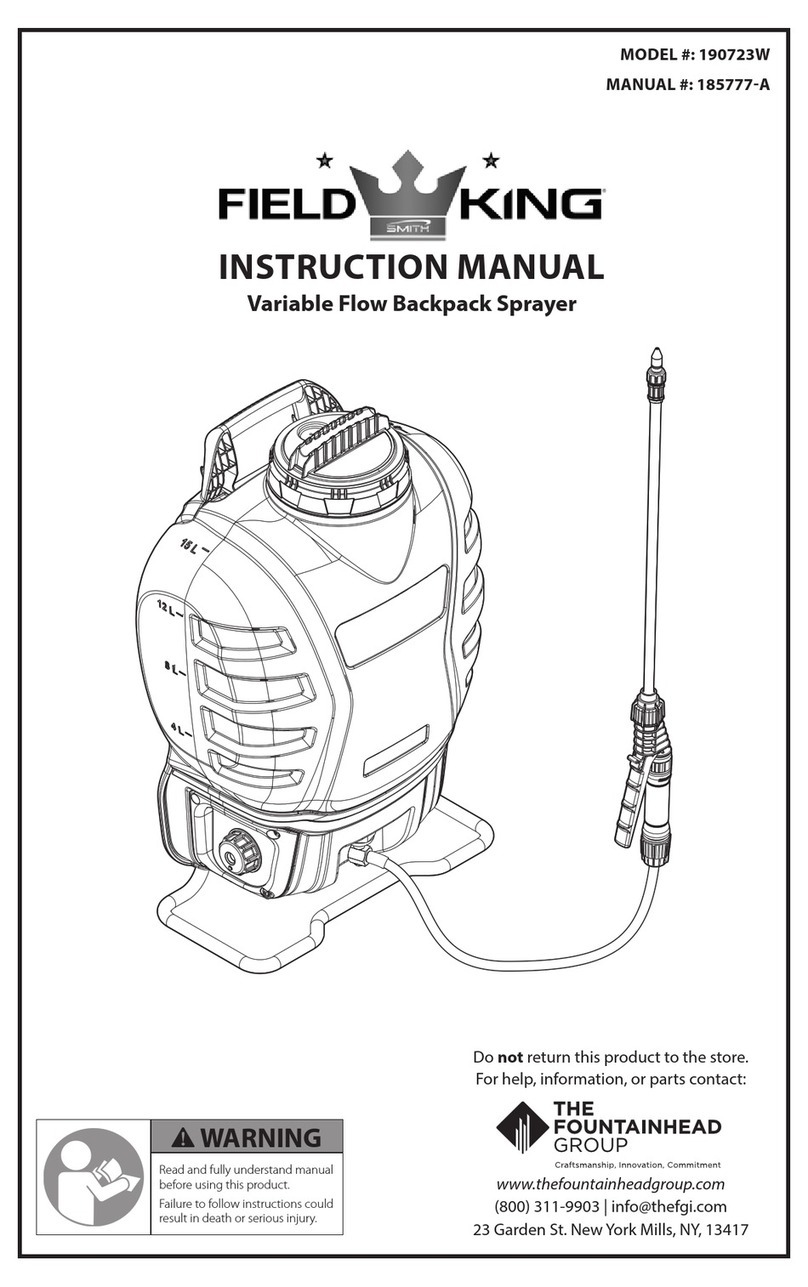
The Fountainhead Group
The Fountainhead Group FIELD KING 190723W instruction manual

Fimco
Fimco LG-30-S 5301478 owner's manual

EUROM
EUROM Backpack 1809 manual
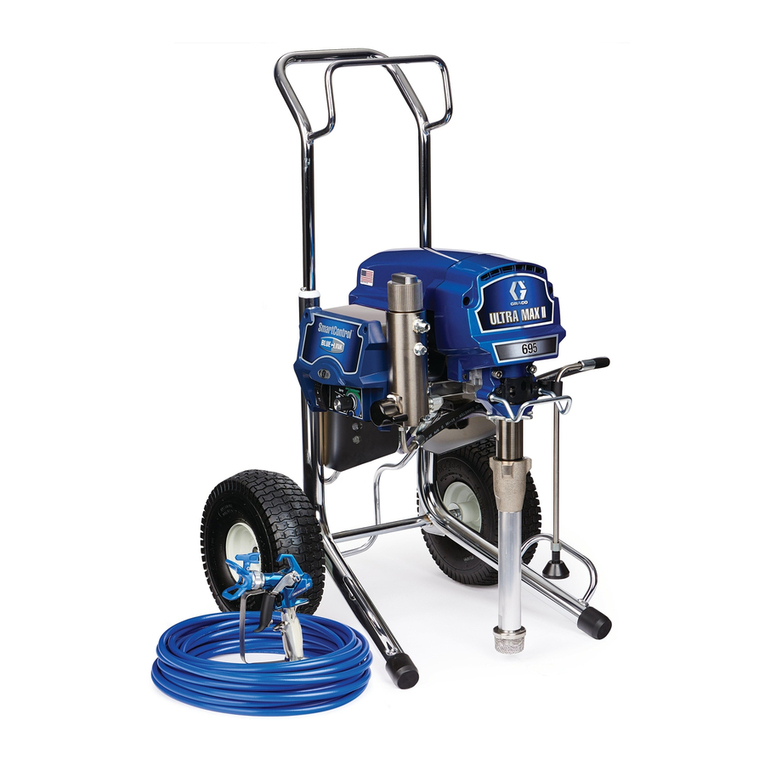
Graco
Graco ULTRA MAX 695 232133 Instructions-parts list

Nordson
Nordson Sure Coat Series Customer product manual
